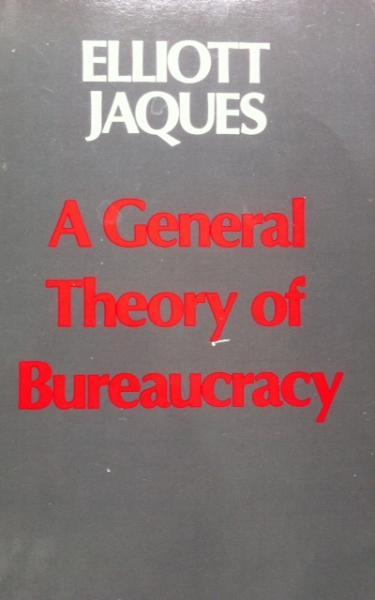A General Theory of Bureaucracy

Obtain this book
Book Review: Elliott Jaques' "A General Theory of Bureaucracy"
Introduction
Elliott Jaques' "A General Theory of Bureaucracy" (1976) represents a landmark contribution to organizational theory, drawing on nearly three decades of research, including the 28-year Glacier Project and extensive work with healthcare organizations, civil service departments, and various industrial firms. As a psychoanalyst and organizational theorist, Jaques challenges the conventional wisdom that bureaucracy is inherently dehumanizing and instead argues that properly designed "requisite" bureaucracy can be liberating and conducive to human flourishing.
Unlike most thinkers who view bureaucracy as inherently oppressive, Jaques meticulously constructs a comprehensive theory that offers both theoretical depth and practical guidance. His insights into organizational structure, managerial accountability, employee development, and the psychological dimensions of work remain profoundly relevant nearly five decades after publication.
Main Themes
The Nature and Definition of Bureaucracy
Jaques defines bureaucracy precisely as "a hierarchically stratified managerial employment system in which people are employed to work for a wage or salary." This neutral definition allows him to explore the essential features of bureaucratic systems without prejudice.
A critical distinction is established between associations (voluntary groupings of people with common goals) and bureaucracies (hierarchical employment systems created by associations). Bureaucracies are secondary and dependent institutions that cannot exist without an employing body, and their function is to perform work on behalf of this body. The employing association, typically through a governing body, creates bureaucracy to carry out its objectives.
Jaques categorizes bureaucracies into "grant-income" institutions (funded through taxation or donations, like government departments) and "earned-income" institutions (which must generate revenue, like businesses). This distinction affects employment security, with grant-income institutions typically offering institutional tenure while earned-income organizations provide only limited tenure.
Manager-Subordinate Relationships: The Building Block of Bureaucracy
The fundamental relationship in bureaucratic systems is the manager-subordinate pair. This relationship is built on accountability - managers are held accountable not only for their own work but for the work of their subordinates. This accountability necessitates commensurate authority, including the ability to:
- Decide what tasks to delegate to subordinates
- Determine resource allocation
- Veto appointments of unacceptable subordinates
- Assess subordinate performance
- Remove subordinates who cannot perform adequately
Jaques emphasizes that these relationships are emotionally charged, affecting self-esteem, security, and career prospects. Without properly structured relationships, bureaucracies generate pathological levels of anxiety and mistrust.
The optimal span of control (how many direct reports a manager should have) varies greatly by context - from as few as one to as many as fifty or sixty - depending on the complexity of work and the manager's other responsibilities. This contradicts simplistic rules that posited a specific number as universally optimal.
The Stratified Depth-Structure of Bureaucracy
Perhaps Jaques' most significant discovery is what he calls the "depth-structure" of bureaucratic systems - a universal pattern of organizational stratification that appears across cultures, industries, and time periods. Through time-span measurement, Jaques identified organizational strata with boundaries at specific time-spans:
- Stratum 1: Concrete operations; time-span up to 3 months
- Stratum 2: Imaginative concrete thinking; time-span 3 months to 1 year
- Stratum 3: Conceptual thinking; time-span 1 to 2 years
- Stratum 4: Abstract conceptual reasoning; time-span 2 to 5 years
- Stratum 5: Universal reasoning; time-span 5 to 10 years
- Stratum 6: Universal reasoning with intuitive judgments; time-span 10 to 20 years
- Stratum 7: Very long-term strategic thinking; time-span beyond 20 years
These strata correspond to qualitative differences in work complexity and required cognitive capabilities, not merely quantitative increases in complexity. Jaques argues that these strata are not arbitrary but reflect actual discontinuities in human mental functioning.
Interestingly, Jaques found that employees instinctively recognize their "real manager" as the first person above the next stratum boundary. This discovery explains much organizational dysfunction - when managers and subordinates are placed at improper distances (less than one full stratum apart), relationships become muddled, with "straw bosses" and constant bypassing. When they're too far apart (more than one stratum), communication breaks down due to vastly different conceptual frameworks.
Work-Capacity and Levels of Abstraction
Jaques proposes that the stratified depth-structure of bureaucracy reflects corresponding stratification in human cognitive capacity. Rather than viewing human abilities as continuously distributed, he argues that work-capacity is distributed multi-modally, with distinct population subgroups corresponding to different levels of abstraction:
- Perceptual-motor concrete (Stratum 1): Working directly with concrete objects through immediate physical manipulation
- Imaginal concrete (Stratum 2): Mentally picturing concrete scenarios but adding interpretation
- Imaginal scanning (Stratum 3): Building comprehensive pictures by scanning multiple elements
- Conceptual modeling (Stratum 4): Working with abstract models detached from concrete reality
- Intuitive theory (Stratum 5): Operating with intuitive theoretical constructs requiring only occasional concrete verification
- Higher levels (Strata 6-7): Creating new institutions and systems
These levels represent qualitative shifts in how individuals perceive and solve problems, not just quantitative increases in intelligence. Each person's work-capacity appears to follow a predictable growth trajectory across their career, typically maturing fully by ages 35-40, though people with higher potential continue developing longer.
Measurement of Work: Time-Span of Discretion
One of Jaques' most practical contributions is the "time-span of discretion" measure - an objective method for determining a role's level. Time-span refers to the longest period a person must exercise judgment before their manager can determine if they've performed acceptably.
This provides an objective measure beyond subjective job descriptions or titles. Remarkably, Jaques found a strong correlation (r=0.89) between the time-span of a role and what employees felt was "fair pay" for that level of responsibility. This suggests time-span measures something fundamental about how humans experience responsibility.
The C-W-P Equilibrium
Jaques introduces a critical equilibrium he terms the C-W-P balance: Capability (C), Level of Work (W), and Payment (P). When these three elements are in equilibrium, employees experience satisfaction and organizational effectiveness increases. Disequilibrium in any dimension creates problems:
- When capability exceeds level of work (C > W): Employees feel underutilized and bored
- When level of work exceeds capability (W > C): Employees feel anxious and overwhelmed
- When payment doesn't match level of work (P ≠ W): Employees feel unfairly treated
The theory suggests organizations should strive to match these three elements for each employee.
The Four Basic Rights of Employees
For bureaucracies to function humanely, Jaques identifies four essential employee rights:
- The right to abundant employment and individual opportunity: Society must provide sufficient jobs matching the distribution of human capacities. Under-employment (work below capacity) causes boredom and frustration, while over-employment (work beyond capacity) creates anxiety and disorganization.
- The right to participate in controlling change: Employees must collectively influence policies affecting their future. Jaques critiques common participation models as inadequate, advocating instead for constitutional systems where employee representatives negotiate with management on any change they deem significant.
- The right to equitable reward: Pay should reflect the level of work performed, with objective measures like time-span ensuring fair differentials.
- The right to individual appeal: Employees must have access to impartial appeals procedures when they believe they've been treated unfairly.
These rights form the foundation of what Jaques calls "constitutional bureaucracy," where power is legitimated through appropriate institutional mechanisms rather than exercised arbitrarily.
Role Relationships Beyond Manager-Subordinate
Jaques identifies a spectrum of lateral role relationships that go beyond the traditional simplistic "line versus staff" distinction:
- Prescribing relationships: Where one role can set limits and prescribe work for another
- Supervisory relationships: Helping a manager oversee work without full managerial authority
- Attachment relationships: When specialists are attached to departments while maintaining their professional reporting line
- Staff specialist relationships: Subject matter experts who advise on policies and practices
- Monitoring relationships: Roles that ensure compliance with standards but cannot direct work
- Advisory relationships: Providing expert advice without authority to implement
- Service-getting relationships: Requesting services from support functions
This nuanced taxonomy recognizes that organizational relationships aren't binary but exist on a spectrum of accountability and authority.
The Dynamics of Bureaucracy
Bureaucracies aren't static - they evolve as employees mature in their work-capacity. When key employees (especially executives) cross stratum boundaries in their personal development, organizations face pressure to expand or restructure. For example, when a Stratum 3 CEO develops Stratum 4 capacity, the entire organization typically transforms, often expanding tenfold in size.
This developmental dynamic explains much about corporate growth patterns that might otherwise seem purely market-driven. Different departments within organizations also have different dynamics - research departments might emphasize rapid progression and turnover, while production might prioritize stability.
Key Insights
The Universal Depth-Structure
Jaques' discovery of consistent organizational strata across diverse contexts suggests an underlying reality to bureaucratic structures that transcends culture and ideology. This provides a scientific foundation for analyzing organizations according to natural laws rather than arbitrary preferences.
Multi-Modal Distribution of Human Capacity
The theory challenges the common assumption that human abilities follow a continuous bell curve distribution. Instead, Jaques posits that work-capacity is distributed in distinct modal groups corresponding to qualitatively different cognitive capabilities. This explains why organizations naturally stratify and why some individuals seem to "hit a ceiling" in their careers.
The Predictable Growth of Individual Capacity
Jaques' capacity progression array - showing how individuals develop along predictable trajectories throughout their careers - offers profound implications for talent management. Organizations can better plan succession by understanding these natural developmental patterns.
Requisite Organization
"Requisite organization" is Jaques' term for bureaucratic structures that match organizational design to the natural strata of human capability. Key principles include:
- Manager-subordinate relationships should span exactly one stratum
- Work should match capability
- Clear accountability and authority
- Fair differential rewards
When these principles are violated, bureaucratic pathologies emerge - the very dysfunctions critics associate with bureaucracy.
Measurement Through Time-Span
The time-span measure provides an objective tool for assessing roles regardless of technical content, industry, or cultural context. This allows for meaningful comparison across traditionally incomparable jobs - from factory work to creative professions to executive leadership.
Constitutional Systems for Employee Participation
Jaques' emphasis on explicit constitutional arrangements between employing associations and employee associations provides a practical framework for effective participation. Unlike many participation models that confuse power dynamics, Jaques' approach recognizes the reality of competing interests while establishing mechanisms for their resolution.
The Root Causes of Bureaucratic Dysfunction
Rather than blaming personality conflicts or cultural factors, Jaques identifies structural misalignments as the primary source of bureaucratic pathologies. When managers and subordinates are at improper distances, when authority doesn't match accountability, or when appeal systems are inadequate, dysfunction inevitably follows.
Practical Applications and Case Studies
Throughout the book, Jaques illustrates his theories with concrete examples from the Glacier Project and other organizations:
- The Problem of Middle Management: Using time-span analysis to identify and eliminate redundant management layers.
- The Supervisory Problem: Distinguishing between supervisory roles (which assist managers) and true managerial roles.
- The Three-Stratum Enterprise: Identifying the three-stratum enterprise (roughly 200-300 employees) as the largest organization where everyone can know everyone else.
- Professional Organization: Distinguishing between different modes of work organization and showing how professional organizations often require structures where managers remain practitioners.
- Growth Challenges: Detailing how organizations typically evolve through strata as they grow, with significant transitions requiring changes in management approach.
Applications for Senior Executives
For senior executives, Jaques' theory offers several powerful applications:
- Diagnosing Organizational Malaise: Using the stratum model to identify where organizational structures are misaligned with human capabilities.
- Succession Planning: Understanding cognitive capability development curves to identify future executive potential early in careers.
- Compensation Design: Using the equitable work-payment scale as an objective basis for compensation structures.
- Organizational Design: Following clear guidelines for designing organizational structures that match human capabilities.
- Leadership Development: Targeting development of specific capabilities required to move between strata.
Critical Evaluation
While Jaques' theory is comprehensive and empirically grounded, several critiques can be raised:
- Cognitive Focus: The theory emphasizes cognitive capabilities over other leadership qualities like emotional intelligence or cultural sensitivity.
- Cultural Assumptions: The research base draws heavily from Western industrial contexts, potentially limiting its cross-cultural applicability.
- Technological Change: The rapid pace of technological change may be altering the nature and time-horizons of work in ways not fully captured by Jaques' model.
- Measurement Challenges: While time-span measurement is theoretically elegant, its practical application requires considerable expertise and judgment.
Conclusion: The Enduring Value of Jaques' Theory
Elliott Jaques' "A General Theory of Bureaucracy" represents a landmark contribution that remains profoundly relevant today. In an era where organizations face unprecedented complexity and workers demand greater meaning and agency, Jaques offers both theoretical depth and practical guidance.
The book's core insight—that organizational strata should match natural discontinuities in human cognitive capabilities—provides a powerful framework for diagnosing organizational problems and designing more effective structures. By grounding organizational design in human cognitive architecture rather than management fads, Jaques offers an approach that is both humanistic and practical.
Most fundamentally, Jaques challenges us to reimagine bureaucracy not as a necessary evil but as a potentially liberating institution. When requisitely organized, bureaucracies can provide meaningful work, fair rewards, and opportunities for genuine participation. They can strengthen rather than undermine democratic societies by creating intermediary power centers between the individual and the state.
While some aspects of Jaques' work remain controversial - particularly his views on innate cognitive differences - his meticulous research and rigorous theory-building set a standard for organizational thinking that few have matched. For anyone seeking to understand the deep structure of organizations or design more effective and humane workplaces, "A General Theory of Bureaucracy" remains essential reading nearly half a century after its publication.





